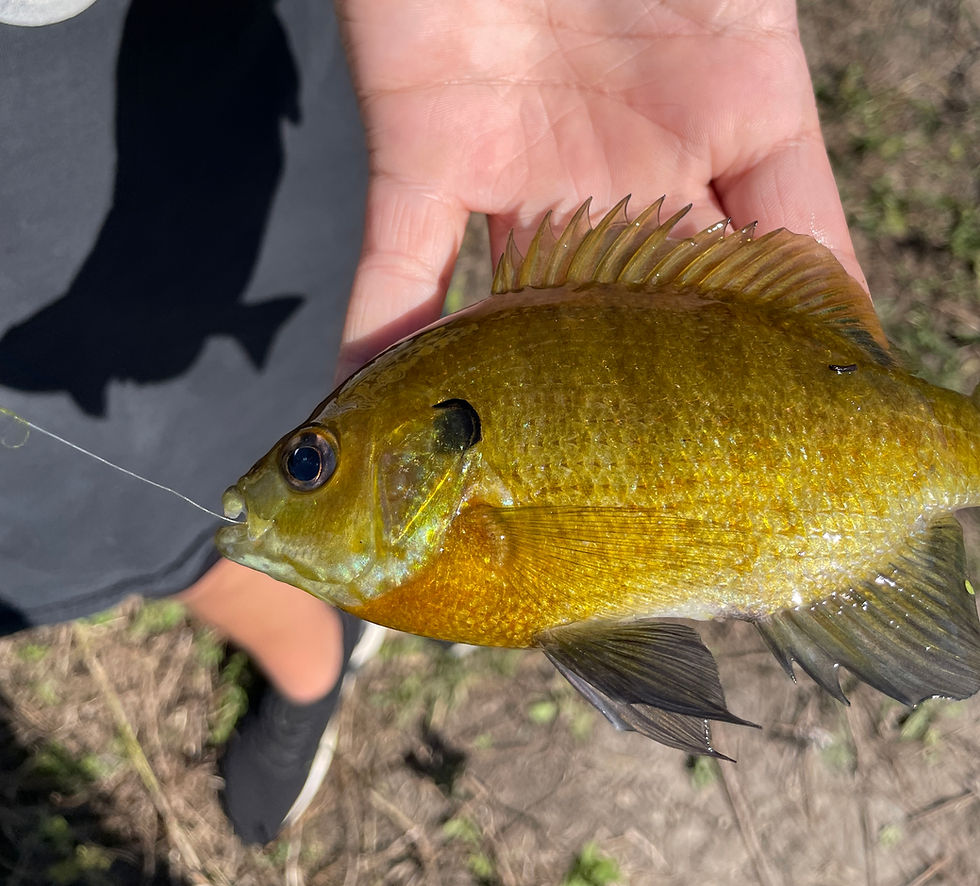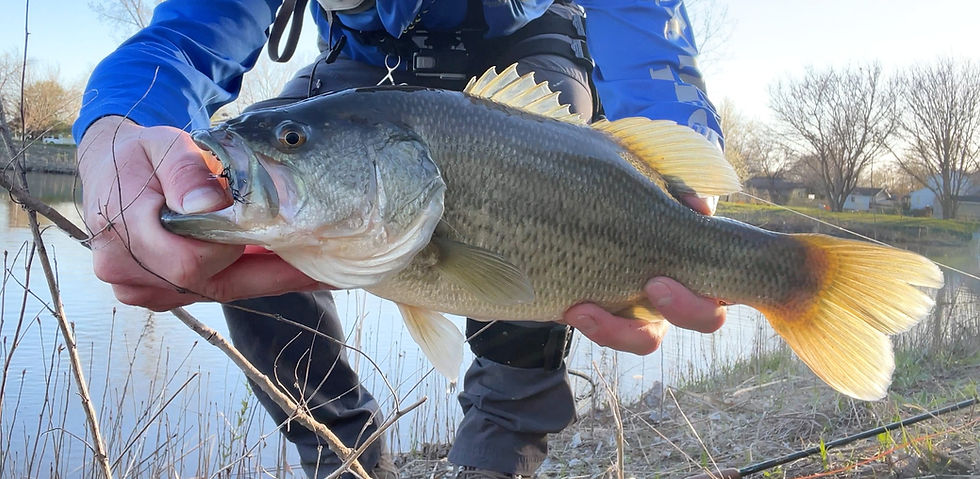Pond Fly Fishing Tactics: Largemouth Bass and Bluegill
- Ryan Koch
- Apr 26, 2024
- 5 min read

While Iowa isn't known for having thousands of lakes like its neighbor state to the north, it is quickly becoming a great place for those pursuing fish in urban and suburban areas. Ponds are popping up in more and more parts of developed parts of the state, as builders and developers are learning that ponds add value to properties, add appeal for local recreation like fishing, and also help add a few wetland habitats back to a state that was once dominated by wetlands and prairies. Families, young kids, and casual anglers are able to take advantage of access to many of these ponds to pursue largemouth bass, bluegill, channel catfish, and other fish species.

Particularly in the Des Moines area, we see new ponds every year in developments that often allow public access to these ponds. While it is not true that "any pond stocked by the DNR is public" (the DNR generally does stock public ponds initially), cities are trying to find ways to get more people outside and enjoying the outdoors in their own communities, and fishing in public areas is one of those avenues. Having ponds that are publicly accessible also encourages people to give critical thought to their natural resources-ponds, lakes, and rivers- and hopefully prompts them to ask questions about how to promote sustainability and conservation in their communities.
The best resource we have in Iowa to determine which ponds are public and private is the DNR's Fish Local Page. Tyler Stubbs, the Urban Fisheries Biologist with the DNR, is always hard at work to keep the map updated with any new public ponds that are built.
If you're not sure where to start, be sure to contact us about a guided fly fishing trip. We run 1/2 Day Guided Trips on our local ponds, with casting lessons available to be built-in to the experience, and these trips are a great way to learn how to dissect your local pond.
Fly Fishing Tactics for Urban/Suburban Ponds
1. Topwater!
If you're a topwater junkie, it's hard to beat fishing topwater popper presentations in our urban ponds for largemouth and bluegill. Even crappie will eat poppers sometimes. Focus on mornings and evenings if topwater is your game, and don't be afraid to vary your retrieve speeds: some fast, some slow. The more pressured ponds will possibly require a slower, more subtle retrieve, while less pressured ponds will likely hold some fairly aggressive fish. Cast along structure or weedy edges; the longer the cast, the more likely you will be to fool a spooky fish.

2. Nymph Rigs: Finding the Fish

Depending on your state, you are allowed to fish multiple hooks per rod. In Iowa, you are allowed two hooks per rod, so that means that you can legally fish two flies at once. One of my favorite searching setups, especially when exploring new ponds, is using two attractor nymphs underneath a bobber/strike indicator - potentially one larger nymph paired with a smaller nymph. You might be surprised how many fish you can get to eat nymphs in ponds, and I even had a pond this spring where I caught bass over and over again on a size 16 nymph. Bluegill, sunfish, and crappie are generally the ones that find nymphs appealing, but you just never know what might take a swipe at one of your nymphs. One of the largest pond bass I've ever caught in Iowa was on a size 16 Copper John nymph.

3. Search for Structure
Structure is always a good thing in any waterbody, and ponds are no different. Pieces of structure to look for in ponds include: inflow and outflow drains, rock piles, docks, points, weedy edges, and shallow flats bordered by drop-offs into deeper water. As you move throughout the seasons, you will find that these pond fish tend to move around to different structure. Keep exploring in your local pond and see what habits your local fish have.

4. Explore New Ponds!
Especially if you are in the central Iowa area, you have a plethora of public, fishable ponds in your area. If you fish the same pond every day of the week, not only will the fish become wary to your presentations (many of our fish in our suburban ponds are very pressured), but you will be missing out on opportunities to fish even better ponds not far away. There are constantly new ponds popping up. Just this spring, I fished at least 3 new ponds that I didn't even know existed before this year (they were built in 2022-2023). These new ponds are usually shown on the DNR's Fish Local page pretty quickly after they are built, and they can hold some hidden gems.

5. Big Flies for Big Fish
Your best bet for big fish in our local pond, from a fly fishing standpoint, is fishing bigger streamers. Most urban and suburban ponds in Iowa have a largemouth, or potentially a few largemouth, that are in the 3-5 pound range. There aren't necessarily a ton of them, and sometimes some of these fish get harvested (usually legally) by members of the public. If you are up for the challenge, chasing trophy pond largemouth is not an easy task, but they are around. Focus on your low-light times of day, and even consider fishing at night. Bass are more than willing to feed at night, and sometimes the bigger fish aren't active at all during the day, especially during the hot summer months in the Midwest.

Be sure to get in touch with us if you want to learn more about fly fishing ponds in Iowa - there are potentially some great fisheries in your neighborhood.
Fishing Report
Click here for the Iowa DNR's Fishing Report (04/24/2024)
Local Reservoirs: Crappie are starting to move in shallower, and within a week or two, they should be in depths that are very reachable with flies. Other species like bass, walleye, and white bass are also much more attainable quarry with these warming water temperatures.
Local Ponds: Our pond fishing is great right now, with bass and bluegill in their pre-spawn behaviors and will start spawning very soon (bluegill may be spawning any day now, depending on the pond). Be conscientious of the fact that your pond may receive lots of fishing pressure. If your local fish are on spawning beds and constantly being harassed by anglers, don't be afraid to give them a break and minimize their stress levels.
Check the DNR's fish local page for a list of public waterbodies to explore.
Des Moines River: Water temps and levels on the rise, and more white bass/wipers being caught. Walleye still eating as well; look for the deeper seams and edges of deeper holes to find fish. Smallmouth activity heating up too.
Driftless Trout Streams (NE Iowa):
Baetis patterns can still be good, so be sure to have some smaller mayfly imitations or even midge patterns to fool fish that are rising. Flows are still very low at the moment, but with some spring rains, flows may fluctuate in localized areas of the Driftless..
-Copper John (14-18)
-Pink Squirrel (14-18)
-Woolly Buggers
-Parachute Adams (14-20)
Be sure to abide by Iowa's state fishing regulations, and know before you go.
~GUIDED FLY FISHING IN IOWA~
flyfishIA.com








Comments